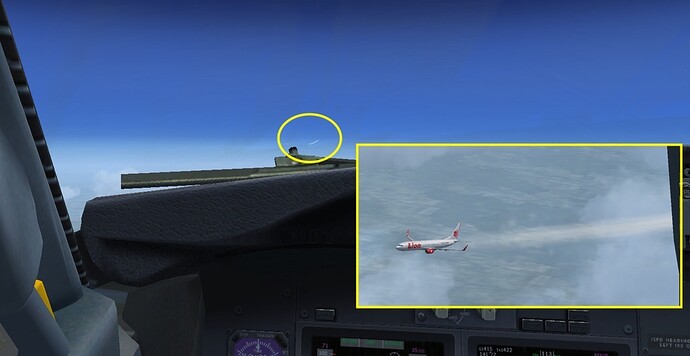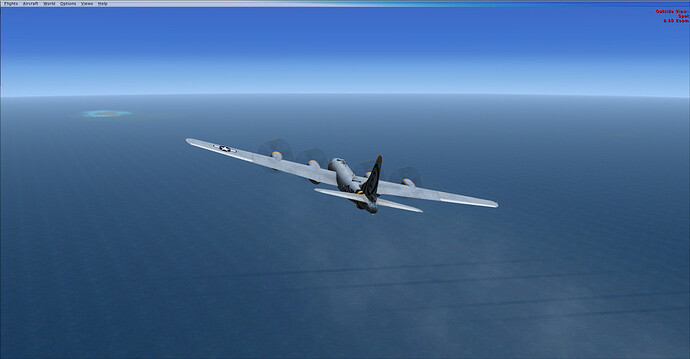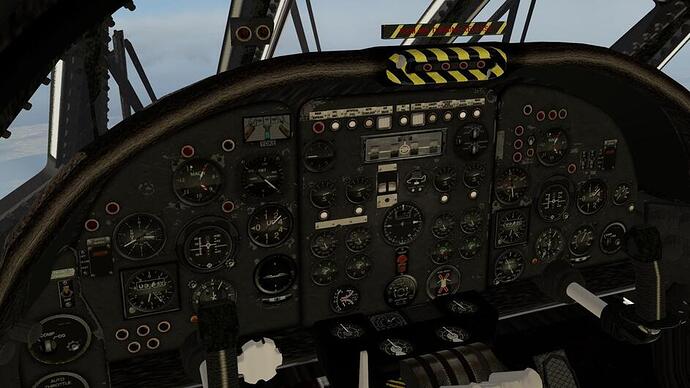So I had some free time today. I had originally planned on making one additional stop, but since I could do it all in one go that’s what happened. The route:
Graciosa Bay to Pago Pago, with Rotuma as a checkpoint roughly halfway. I only had one other leg of more than 1000 NM, so I figured the last one wasn’t a bad place. The presents have been brought, the secondary beer has arrived, but I hadn’t heard anyone say anything about fireworks.
Got us covered.
Virtavia’s B-29. As with all Virtavia/Alphasim products the systems modeling is lacking, but they have some pretty nice models on their current releases.
A B-29 off a 2700’ coral runway you ask? If Cygon_Parrot can land a Space Shuttle in Pago Pago, the least I can do it try and take off in one of the heaviest, most prone to light on fire, long take off run aircraft of WW2. I mean what’s the worst that could go wrong? All that stands between glory, and firey incredibly explosive death is 2700 feet of crushed coral, some palm tree’s, and 8,800 shp not deciding to light itself on fire.
The office for the next few hours. Compared to most other heavy bombers of the time (particularly American ones) was incredibly spacious and airy. The “greenhouse” cockpit was a first, and would carry over to the later B-36. For those who aren’t familiar with the B-29’s troubled operational beginnings, the Wright R-3350 Duplex Cyclones (later used in the Constellation) were prone to lighting themselves on fire. ALOT. For a variety of reasons the engines had tremendous trouble being kept cool. The second prototype built had to abort halfway through the first test flight due to an engine fire, and only 2 months later crashed due to an engine firing killing all on board, as well as 20 on the ground.
So with all that running through my head, there are a couple problems that I have to address with this takeoff. First runway length, this is WAY short for a B-29, usually operating off of 8,000’ or longer runways. It is reasonably warm, 78 degrees OAT, not sweltering but every degree counts. There are tree’s just past the end of the runway, so I need to be climbing as soon as I get the wheels unstuck. Climbing however is slow, which means less air going into the engines, which are already throttled all the way up for takeoff, which means hot engines getting litte cooling. Hmm.
In my favor, it’s about 1300 NM to Pago Pago, so roughly 1/4 of the B-29’s range, we can go very light on fuel. The plan, is to add some extra flap extension to help get us airborne, firewall the throttles, and as soon as we’re airborne and not going to hit terrain, back off from takeoff power, level off to let th engines cool down some. Open up the all the cooling flaps as much as I can for take off, and hopefully nothing lights off.
30 degrees flaps (normal is 15) and 47.5" manifold pressure did the trick (being something like 24,000 lbs of fuel lighter probably helped some too). This rendition of the B-29 has a massive yaw to the right on takeoff, and you’ll spend most of the flight fiddling with the rudder trim. I have no clue if that’s realistic or not. Also I’m pretty sure with Virtavias system modeling, there’s no way to actually torch an engine. Even with that limitation, I do my best to make sure to keep the engine temps under control.
We quickly accelerate to 190 MPH IAS (no clue why the B-29 uses MPH, but it does), which is climb speed, with no over temping. I set 43" and 2400 RPM and head skyward.
FL30, IAS of 240 MPH, per the GPS doing about 340 knots over the ground. Not bad for this old girl. It really is a pretty model. With some deeper systems modeling it could be an epic FS aircraft, but alas I doubt that’s ever going to happen.
Now for a tour, as we’re in the air for about 4 hours.
First up the flight engineers station. 90% of the knobs and switches have no practical effect sadly.
The bombardiers station Norden sight in view. Sadly it is not modeled in anyway shape or fashion.
Same with the nose gun-sighting head swung into position. The B-29 featured an incredibly advanced for it’s time (and today it’s still pretty impressive) system of centralized fire control. Using the sighting heads around the bomber 5 gunners controlled 4 turrets remotely. The gunners job was to simply track the target, range it correctly with the reticle in the sight, and the gunnery computer did the rest. The master gunner could assign from none to all turrets to a sight head, and the computer did all the calculations for lead, range, and parallax (as the sighting heads were well offset from the different gun locations). And all of this occured in pressurized temperature controlled comfort!
Between the seats view.
The autopilot panel, and the radio stack (Com 1, Nav 1, NBD) there is also the default FSX GPS.
Land spotted in the distance, that’s Rotuma, the halfway point roughly.
Real world B-29 missions could last for 12+ hours. As mentioned above the B-29 was fully pressurized and temperature controlled, making it much less fatiguing to sustain these missions. The forward section of the AC was connected to the aft section by a pressurized tunnel that ran through the bomb bays, and usually featured a small wheeled cart you pulled your self over on. The aft section had a galley and berths. The tail gunner, as tail gunners always do, was stuck by himself in the tail gun station. It was pressurized, but there was no pressurized connection to aft crew space. Barring injury or calamity, they were alone in the back from the time the climb started, until the time the AC got back under 10,000’.
I really should have come in from the other side, but that’s what flight simming is for right?*
A beautiful touch down, just about to put weight on the nose gear. I could have had a bit more flare to bleed more speed, but this worked out just fine.
And stopped. 20,000 lbs of New Years eve supplies delivered.
So my overall route covered approximately 12,300 NM and probably ~55 hours of flight time. I flew 19 different AC, ranging from large widebody jets (the VC10) on down to a light GA plane with the SIAI-Marchetti SF.260. Overall it was a great bit of fun, flying a bunch of AC I hadn’t wheeled out of the hanger in a long time, or that I had my eye on for a while. It turned out different than I had planned, but that’s half the fun right?
![]() I’m taking a hiatus from Silicon Valley right now but I was formerly a software engineer.
I’m taking a hiatus from Silicon Valley right now but I was formerly a software engineer.










































































